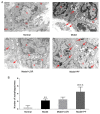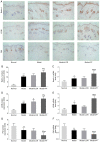Paeoniflorin suppresses allergic and inflammatory responses by promoting autophagy in rats with urticaria
- PMID: 33884028
- PMCID: PMC8056118
- DOI: 10.3892/etm.2021.10022
Paeoniflorin suppresses allergic and inflammatory responses by promoting autophagy in rats with urticaria
Abstract
Paeoniflorin (PF) has been reported to be effective against several skin disorders, such as allergic contact dermatitis and psoriasis; however, it remains unclear whether PF can protect against urticarial lesions. Herein, the effects of PF on rats with urticarial lesions and the possible underlying mechanism were investigated. The effects of PF administration on a rat model of ovalbumin-induced urticarial-like lesions were evaluated via pathological analysis using hematoxylin-eosin staining. Toluidine blue staining was performed to detect mast cells and ELISA was performed to determine serum histamine levels. PF-induced regulatory effects on autophagic activity and the potential underlying mechanism of this were also investigated using transmission electron microscopy, immunohistochemistry and reverse transcription-quantitative PCR. It was demonstrated that PF suppressed allergic and inflammatory responses to improve urticarial lesions, as evidenced by the attenuation of pathological abnormalities, mast cell infiltration and histamine secretion. Mechanistically, PF treatment was found to markedly limit the production and release of inflammatory cytokine interleukin (IL)-23, while the levels of IL-17 remained unchanged. PF intervention led to an increased number of autophagosomes, along with higher levels of light chain 3B (LC3B) and Beclin-1, and lower levels of P62, indicating that PF could augment autophagic activity in urticarial lesions. PF treatment increased the expression of liver kinase B1 (LKB1) and AMP-activated protein kinase-α (AMPK-α), contributing to the PF-enhanced autophagic activity. In conclusion, PF could effectively improve urticarial lesions by inhibiting inflammatory cytokine IL-23 and increasing the autophagic activity via the LKB1/AMPK-α pathway.
Keywords: allergy; autophagy; inflammation; paeoniflorin; urticaria.
Copyright: © Guo et al.
Conflict of interest statement
The authors declare that they have no competing interests.
Figures







Similar articles
-
Circadian Pharmacological Effects of Paeoniflorin on Mice With Urticaria-like Lesions.Front Pharmacol. 2022 Feb 9;12:639580. doi: 10.3389/fphar.2021.639580. eCollection 2021. Front Pharmacol. 2022. PMID: 35222003 Free PMC article.
-
Paeoniflorin protects against intestinal ischemia/reperfusion by activating LKB1/AMPK and promoting autophagy.Pharmacol Res. 2019 Aug;146:104308. doi: 10.1016/j.phrs.2019.104308. Epub 2019 Jun 10. Pharmacol Res. 2019. PMID: 31181335
-
Paeoniflorin inhibits skin lesions in imiquimod-induced psoriasis-like mice by downregulating inflammation.Int Immunopharmacol. 2015 Feb;24(2):392-399. doi: 10.1016/j.intimp.2014.12.032. Epub 2015 Jan 6. Int Immunopharmacol. 2015. PMID: 25576402
-
Paeoniflorin attenuates allergic inflammation in asthmatic mice.Int Immunopharmacol. 2015 Jan;24(1):88-94. doi: 10.1016/j.intimp.2014.11.016. Epub 2014 Nov 26. Int Immunopharmacol. 2015. PMID: 25433342
-
Paeoniflorin inhibits mast cell-mediated allergic inflammation in allergic rhinitis.J Cell Biochem. 2018 Nov;119(10):8636-8642. doi: 10.1002/jcb.27135. Epub 2018 Aug 4. J Cell Biochem. 2018. PMID: 30076630
Cited by
-
Paeoniflorin Protects H9c2 Cardiomyocytes against Hypoxia/Reoxygenation Induced Injury via Regulating the AMPK/Nrf2 Signaling Pathway.Evid Based Complement Alternat Med. 2022 Oct 13;2022:7667770. doi: 10.1155/2022/7667770. eCollection 2022. Evid Based Complement Alternat Med. 2022. Retraction in: Evid Based Complement Alternat Med. 2023 Jun 21;2023:9856193. doi: 10.1155/2023/9856193. PMID: 36276847 Free PMC article. Retracted.
-
Efficacy and safety of total glucosides of paeony as an add-on treatment in adolescents and adults with chronic urticaria: A systematic review and meta-analysis.Front Pharmacol. 2022 Sep 23;13:961371. doi: 10.3389/fphar.2022.961371. eCollection 2022. Front Pharmacol. 2022. PMID: 36263138 Free PMC article.
-
LKB1 Regulates Vascular Macrophage Functions in Atherosclerosis.Front Pharmacol. 2021 Dec 15;12:810224. doi: 10.3389/fphar.2021.810224. eCollection 2021. Front Pharmacol. 2021. PMID: 34975507 Free PMC article. Review.
-
Palmatine treats urticaria by reducing inflammation and increasing autophagy.Front Immunol. 2023 Nov 14;14:1268467. doi: 10.3389/fimmu.2023.1268467. eCollection 2023. Front Immunol. 2023. PMID: 38035098 Free PMC article.
-
Lithosepermic Acid Restored the Skin Barrier Functions in the Imiquimod-Induced Psoriasis-like Animal Model.Int J Mol Sci. 2022 May 31;23(11):6172. doi: 10.3390/ijms23116172. Int J Mol Sci. 2022. PMID: 35682849 Free PMC article.
References
-
- Maurer M, Staubach P, Raap U, Richter-Huhn G, Bauer A, Ruëff F, Jakob T, Yazdi AS, Mahler V, Wagner N, et al. H1-antihistamine-refractory chronic spontaneous urticaria: It's worse than we thought - first results of the multicenter real-life AWARE study. Clin Exp Allergy. 2017;47:684–692. doi: 10.1111/cea.12900. - DOI - PubMed
-
- Li X, Shi F, Zhang R, Sun C, Gong C, Jian L, Ding L. Pharmacokinetics, safety, and tolerability of amygdalin and paeoniflorin after single and multiple intravenous infusions of huoxue-tongluo lyophilized powder for injection in healthy chinese volunteers. Clin Ther. 2016;38:327–337. doi: 10.1016/j.clinthera.2015.12.005. - DOI - PubMed
-
- Lee S, Lim JM, Jin MH, Park HK, Lee EJ, Kang S, Kim YS, Cho WG. Partially purified paeoniflorin exerts protective effects on UV-induced DNA damage and reduces facial wrinkles in human skin. J Cosmet Sci. 2006;57:57–64. - PubMed
LinkOut - more resources
Full Text Sources
Other Literature Sources
